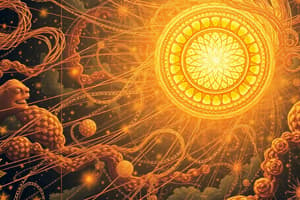Podcast
Questions and Answers
According to Newton's laws of motion, what happens to a body that is not acted upon by a force?
According to Newton's laws of motion, what happens to a body that is not acted upon by a force?
- It remains at rest
- It moves at a constant speed in a straight line (correct)
- It changes direction
- It accelerates
What did Isaac Newton use his three laws of motion to investigate and explain?
What did Isaac Newton use his three laws of motion to investigate and explain?
- The motion of celestial bodies
- The motion of electromagnetic waves
- The motion of physical objects and systems (correct)
- The motion of subatomic particles
According to Newton's laws of motion, what is the relationship between a body's acceleration, mass, and net force?
According to Newton's laws of motion, what is the relationship between a body's acceleration, mass, and net force?
- Acceleration is equal to mass multiplied by net force
- Mass is equal to acceleration multiplied by net force
- Acceleration is equal to net force divided by mass (correct)
- Net force is equal to acceleration multiplied by mass
According to Newton's third law of motion, what is the relationship between the forces exerted by two bodies on each other?
According to Newton's third law of motion, what is the relationship between the forces exerted by two bodies on each other?
When were Newton's laws of motion first stated?
When were Newton's laws of motion first stated?
Which fundamental interaction is the strongest?
Which fundamental interaction is the strongest?
Which fundamental interaction is the weakest?
Which fundamental interaction is the weakest?
At what scale does gravity have no significant influence?
At what scale does gravity have no significant influence?
What does gravity determine the motion of?
What does gravity determine the motion of?
What biological function does gravity have?
What biological function does gravity have?
Flashcards
Newton's First Law
Newton's First Law
A body remains at rest or moves at a constant speed in a straight line unless acted upon by a force.
Newton's Laws Application
Newton's Laws Application
Newton used his three laws of motion to investigate and explain the motion of physical objects and systems.
Newton's Second Law
Newton's Second Law
Acceleration is directly proportional to net force and inversely proportional to mass (F=ma).
Newton's Third Law
Newton's Third Law
Signup and view all the flashcards
Year of laws?
Year of laws?
Signup and view all the flashcards
Strongest Force
Strongest Force
Signup and view all the flashcards
Weakest Force
Weakest Force
Signup and view all the flashcards
Gravity's Scale
Gravity's Scale
Signup and view all the flashcards
Gravity's Influence
Gravity's Influence
Signup and view all the flashcards
Gravity and Plants
Gravity and Plants
Signup and view all the flashcards
Study Notes
Newton's Laws of Motion
- A body that is not acted upon by a force remains at rest or continues to move with a constant velocity.
- Isaac Newton used his three laws of motion to investigate and explain the motion of objects on Earth and in the universe.
Newton's Second Law of Motion
- There is a direct relationship between a body's acceleration, mass, and net force: acceleration is directly proportional to net force and inversely proportional to mass.
Newton's Third Law of Motion
- The forces exerted by two bodies on each other are equal in magnitude and opposite in direction.
History of Newton's Laws of Motion
- Newton's laws of motion were first stated in the late 17th century.
Fundamental Interactions
- The strongest fundamental interaction is the strong nuclear force.
- The weakest fundamental interaction is gravity.
Gravity
- Gravity has no significant influence at the atomic and subatomic scale.
- Gravity determines the motion of planets, stars, and galaxies.
- Gravity plays a crucial biological function in maintaining the structure and function of living organisms, particularly in the case of plants and animals.
Studying That Suits You
Use AI to generate personalized quizzes and flashcards to suit your learning preferences.




